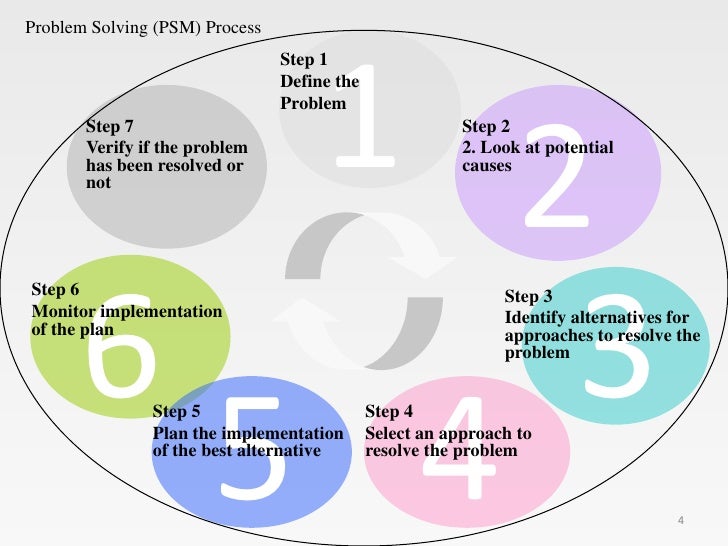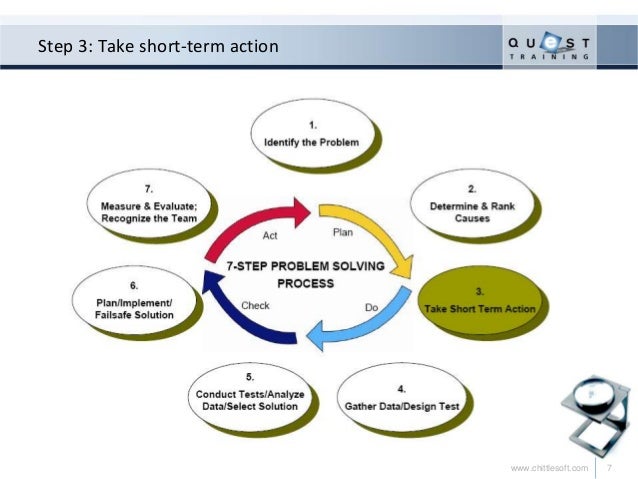7-step Problem Solving Process For The Suppliers Pdf
- Problem Solving Process For Kids
- Problem Solving Process For Electrical
- 7-step Problem Solving Process For The Suppliers Pdf Free
7-step Problem Solving Process For The Suppliers Pdf Writer. 7-Step Problem Solving Process For The. A standardized approach for team based problem solving. The Human Consequences Pdf. Process Problem Report and Resolution Including 5 why. PROBLEM SOLVING (root cause / “drill-deep”). Request (SCAR) is based on a conventional 7-Step. Data Collection and A nalysis Explore the problem through exploration Identify root cause of the problem Design checksheets Collect the data A nalyze data: Pareto diagrams Ishikawa creation and evaluation V erification of root cause(s) using more data collection 3.7 Steps Problem Solving Process: Review STEP PURPOSE A CTIV ITIES 1. THE-4: 7-Step Problem Solving Process for Truck & Heavy Equipment Suppliers (Secured file - cannot be printed) The Seven-Step Problem-Solving Process provides a comprehensive checklist of actions to be considered for each of the steps or phases of developing corrective and preventive actions to a problem. 7-step Problem Solving Process For The Suppliers Pdf Free. Turner Gas Company. Our products include wholesale propane, natural gas liquids, chemicals, and crude. Turner Gas Company is family- owned and has successfully served customers for over 7.
Being a successful leader doesn’t mean that you don’t have any problems. Rather, it means that you know how to solve problems effectively as they arise. If you never had to deal with any problems, chances are pretty high that your company doesn’t really need you. They could hire an entry-level person to do your job!
- ⇒Supplier’s Percent Lot Accepted Quality Metric will show reject. Process/data driven problem solving approach. If you require assistance, please contact the buyer. Structured Problem Solving. 8D-Root Cause Analysis. Corrective Action Implementation.
- 7-step Problem Solving Process For The Suppliers Pdf Writer We are representing the 7 steps for effective problem solving. Seeking Meaningful Ways of Problem Solving It is usually easier to advise others how to react in a particular problematic situation than to confront the same situation ourselves.
- 7-Step Problem Solving Process for. 7-Step Problem Solving Process for Truck & Heavy Equipment Suppliers. Step Problem Solving Process For The Suppliers Pdf. Problem Solving to Align Purpose, Process and People. Creating the Culture of Problem Solving. Problem- Solving Process 3. Suppliers may be required to implement. Supplier Quality Handbook.
Unfortunately, there are many examples of leaders out there who have been promoted to management or leadership positions because they are competent and excel in the technical skills needed to do the work. These people find themselves suddenly needing to “think on their feet” and solve problems that are far more high-level and complicated than they’ve ever really had to deal with before. Are there tools available to these people to help them solve the problem correctly and effectively? Absolutely!
Today, I am going to introduce you to the Seven Steps of Effective Problem Solving that Bullet Proof® Managers are learning about, developing, and implementing in their teams.

Step 1: Identify the Problem
What are things like when they are the way we want them to be?
This question helps you find the standard against which we’re going to measure where we are now. If things were going the way we want them to go, what does that look like? If this person were doing the job we want him or her to do, what would they be doing? Cyberseal secure cracked by methodist church.
And then ask this important question: How much variation from the norm is tolerable?
Therein lies the problem. From an engineering perspective, you might have very little tolerance. From a behavioral perspective, you might have more tolerance. You might say it’s okay with me when this person doesn’t do it exactly as I say because I’m okay with them taking some liberty with this. Some other issue you may need 100% compliance.
Step 2: Analyze the Problem
At what stage is this problem? This helps you identify the urgency of the problem, and there are generally three stages.
The emergent stage is where the problem is just beginning to happen. It does not cause an immediate threat to the way business operates every day. It is just beginning to happen and you have time on your side to be able to correct it without it causing much damage to the processes it is affecting.
The mature stage is where this problem is causing more than just minor damage. Some amount of damage has been done, and you need to jump on it immediately to fix it before it becomes a problem where the consequences may be greater, deeper, and more expensive if we don’t solve this problem fast.
The third stage is the crisis stage, when the problem is so serious it must be corrected immediately. At this stage, real damage has been done to company processes, reputation, finances, etc. that will have potentially long-term effects on your ability to do business.

Step 3: Describe the Problem
You should be able to describe a problem by writing it in the form of a statement and you should do it in 12 words or less, assuming it’s not a complicated, scientific problem. This way, you have clarity exactly what the issue is. Then, perhaps try distributing it to your team to ensure they agree that this is the root of the problem, that it makes sense, and everyone that is working toward a solution is working toward the same goal.
The most important question of all, when describing your problem: Is your premise correct?
Let me give you an example of what I mean. We’ve all heard – or read – the story of the engineer’s take on the old “half empty, half full” question. A speaker holds up the glass of water and asks if the glass is half empty or half full, a discussion within the group ensues, and you generally expect some sort of lesson in optimism, etc. from it. In this version, an engineer is in the room and answers, “I see this glass of water as being twice the size it needs to be.”
You see, sometimes when you are the one in charge of the problem, you tend to set the premise of the problem from your own perspective. But, that premise may not be accurate, or it may just need an alternate perspective from which to see it. If your premise is not correct, or at least incomplete, you are not fully understanding the problem and considering all the best options for a solution.
Step 4: Look for Root Causes
This step involves asking and answering a lot of questions. Ask questions like: What caused this problem? Who is responsible for this problem? When did this problem first emerge? Why did this happen? How did this variance from the standard come to be? Where does it hurt us the most? How do we go about resolving this problem?
Also, ask the most important question: Can we solve this problem for good so it will never occur again? Because an important aspect to leadership is coming up with solutions that people can use for a long-term benefit, rather than having to deal with the same problems over and over and over.
Step 5: Develop Alternate Solutions
Just about any problem you have to deal with has more solutions to it than the one that you think of first. So, it is best to develop a list of alternate solutions that you and your team can assess and decide which one will be the best for the particular problem. I often use the ⅓ + 1 Rule to create consensus around one – or the top two or three solutions – that will be best for everyone involved.
Problem Solving Process For Kids
Then rank those solutions based on efficiency, cost, long-term value, what resources you have and that you can commit to the solution of the problem. Then, look at every one of those solutions carefully and decide what you believe to be the best solution to this problem at this time.
Step 6: Implement the Solution
Implementing the solution you decide on can include creating an implementation plan. It could also include planning on what happens next if something goes wrong with the solution if it doesn’t work out the way you thought it would. Implementation means that everyone on your team knows and understands their part in making the solution work, that there are timelines for execution, and also that you have a system in place to track whether or not the solution has corrected the problem.
Step 7: Measure the Results
From your implementation plan in step 6, make sure you track and measure the results so you can answer questions such as: Did it work? Was this a good solution? Did we learn something here in the implementation that we could apply to other potential problems?
Problem Solving Process For Electrical
These seven simple steps will help you become a more effective, efficient problem solver in your organization. As you practice this process and develop the skills, these steps will become more natural to you until the point that you are using them without noticing!